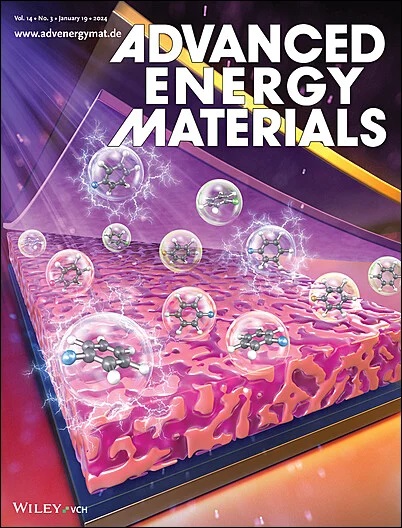实际条件下锂金属电池用快速动力学lino3基电解质
IF 24.4
1区 材料科学
Q1 CHEMISTRY, PHYSICAL
引用次数: 0
摘要
为了在商业上可行,锂金属电池(lmb)的电解质必须在极端条件下(高阴极负载、低负极/正极比和低电解质/阴极比)实现长循环寿命和快速充电特性。虽然基于lifsi的电解质通常可以延长lmb的循环寿命,但它们通常在动力学方面存在不足。这项研究首次证明了基于lino3的电解质可以同时在lmb中实现优异的可逆性和快速动力学,优于目前最先进的基于lifsi的电解质。值得注意的是,LiNi0.8Co0.1Mn0.1O2 (NCM811) ||锂电池在430次循环后显示出80%的容量保持率,并且在实际条件下(20 mg cm - 2 NCM811, 50 μ m Li箔和5.6 mL Ah - 1电解质)具有出色的倍率性能(在12 mA cm - 2时2.35 mAh cm - 2)。快速动力学可归因于锂离子通过体电解质和电极/电解质界面的有效运输。这项工作强调了低成本LiNO3盐的重要性,并提出了在极端条件下实现锂金属电池卓越性能的替代途径。本文章由计算机程序翻译,如有差异,请以英文原文为准。

LiNO3-Based Electrolyte with Fast Kinetics for Lithium Metal Batteries Under Practical Conditions
To be commercially viable, the electrolyte for lithium metal batteries (LMBs) must enable both long cycle life and fast charging characteristics under extreme conditions (high cathode loading, low negative/positive ratio, and low electrolyte/cathode ratio). While LiFSI-based electrolytes typically provide LMBs with extended cycle life, they often fall short in terms of kinetics. This study, for the first time, demonstrates that the LiNO3-based electrolyte can simultaneously achieve excellent reversibility and rapid kinetics in LMBs, outperforming state-of-the-art LiFSI-based electrolytes. Notably, LiNi0.8Co0.1Mn0.1O2 (NCM811) || Li batteries exhibit 80% capacity retention after 430 cycles, along with outstanding rate performance (2.35 mAh cm⁻2 at 12 mA cm−2) under practical conditions (20 mg cm−2 NCM811, 50 µm Li foil, and 5.6 mL Ah⁻¹ electrolyte). The rapid kinetics can be attributed to the efficient transport of lithium ions through both the bulk electrolyte and the electrode/electrolyte interphases. The work highlights the significance of low-cost LiNO3 salt and presents an alternative pathway to achieving superior performance for lithium metal batteries under extreme conditions.
求助全文
通过发布文献求助,成功后即可免费获取论文全文。
去求助
来源期刊

Advanced Energy Materials
CHEMISTRY, PHYSICAL-ENERGY & FUELS
CiteScore
41.90
自引率
4.00%
发文量
889
审稿时长
1.4 months
期刊介绍:
Established in 2011, Advanced Energy Materials is an international, interdisciplinary, English-language journal that focuses on materials used in energy harvesting, conversion, and storage. It is regarded as a top-quality journal alongside Advanced Materials, Advanced Functional Materials, and Small.
With a 2022 Impact Factor of 27.8, Advanced Energy Materials is considered a prime source for the best energy-related research. The journal covers a wide range of topics in energy-related research, including organic and inorganic photovoltaics, batteries and supercapacitors, fuel cells, hydrogen generation and storage, thermoelectrics, water splitting and photocatalysis, solar fuels and thermosolar power, magnetocalorics, and piezoelectronics.
The readership of Advanced Energy Materials includes materials scientists, chemists, physicists, and engineers in both academia and industry. The journal is indexed in various databases and collections, such as Advanced Technologies & Aerospace Database, FIZ Karlsruhe, INSPEC (IET), Science Citation Index Expanded, Technology Collection, and Web of Science, among others.
 求助内容:
求助内容: 应助结果提醒方式:
应助结果提醒方式:


